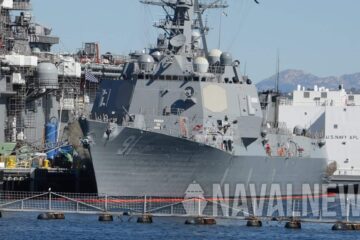A US Navy Admiral has assumed command of NATO’s Standing NATO Maritime Group (SNMG) 1, taking over from a Royal Danish Navy Commodore.
In a ceremony marking the hand-over in Copenhagen on Monday (14 January 2019), Rear Admiral Edward Cashman of the US Navy said: “The North Atlantic is a bridge that connects the Allies, not a barrier that separates them. That connectivity is even stronger today and more important than ever to our security and to our prosperity.”
Rear Admiral Cashman will command the group from the new flagship, the USS Gravely. At the same ceremony, the Royal Danish Navy’s Commander Peter Krogh took command of Standing NATO Mine Countermeasures Group (SNMCMG) 1, succeeding a Belgian Navy commander.
NATO’s standing naval forces are integrated into the NATO Response Force, and provide the Alliance with a continuous presence at sea. These multinational forces regularly carry out patrols, exercises and port visits, work with partners, and can be rapidly deployed in times of tension or crisis. They also support the Alliance’s Aegean deployment – helping to cut lines of illegal migration between Greece and Turkey.
NATO’s naval forces consist of four groups: Standing NATO Maritime Groups 1 and 2, and Standing NATO Mine Countermeasures Groups 1 and 2.
SNMG1 now consists of the US flagship USS Gravely and Germany’s FGS Spessart. SNMG2 is led by the Dutch flagship HNLMS Evertsen and Canada’s HMCS Ville de Québec, while SNMG2’s Aegean deployment is led by Germany’s FGS Bonn and joined by Albanian vessel ALS Lisus, Greek vessels HS Maridakis, HS Mykonios, and HS Polemistis, and Turkish vessel TCG Kumkale.
SNMCMG1 is now led by Danish flagship HDMS Thetis, joined by Germany’s FGS Dillengen; and SNMCMG2 is under German command, with the FGS Werra serving as flagship.







Halidon
Admiral on a BURKE, bet it’s pretty crowded on her about now.